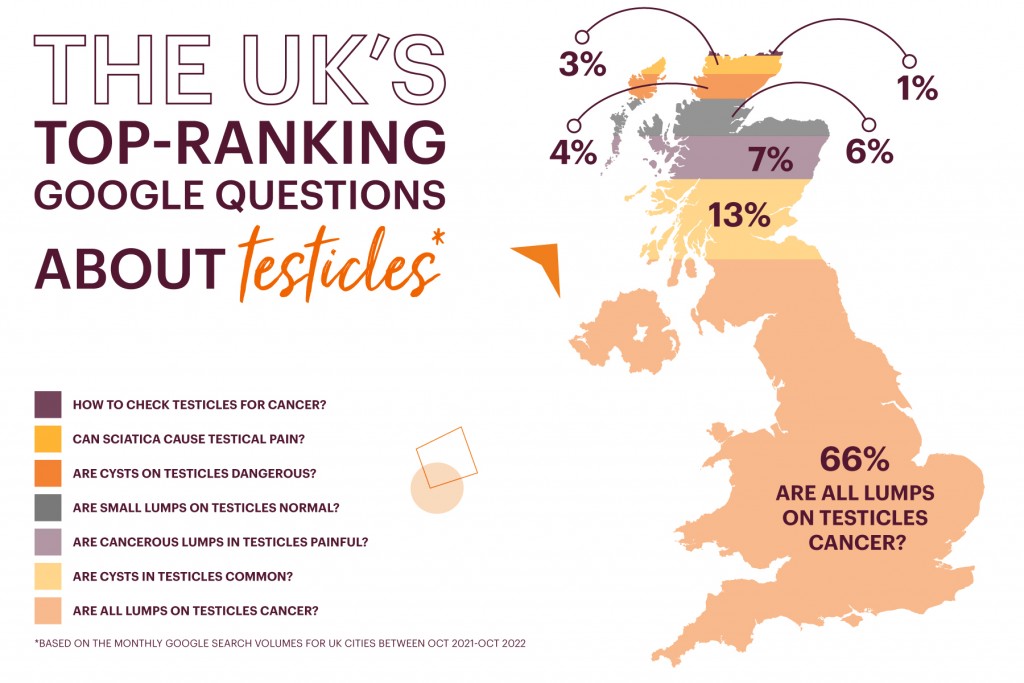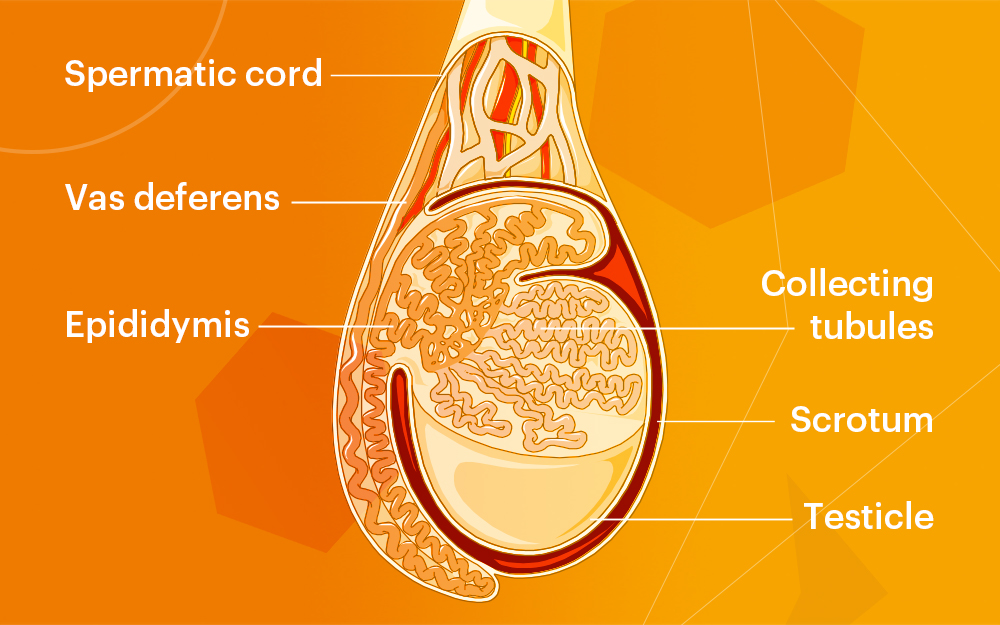
Our young men are being “grabbed by the balls” – the cunning enemy’s intention? To yank them off
Over the course of our series of blogs in support of Men’s Health Awareness Month, we considered what it was that UK men really wanted to know about their health, or more specifically, their balls. So, we asked Google. Turns out everyone pretty much wanted to know the same thing; are lumps on one’s nuts always cancerous?

Lumps or swelling on the testicles are a relatively common symptom in those with crown jewels, and are mostly nothing to worry about.1 But it’s important to recognise the symptoms of testicular cancer, and know what is normal for you, so you can check with your GP if something seems out of the ordinary.1
Ancient Greek philosophy suggested that tying off the male left testicle would produce sons.2 Today, thousands of UK men face the loss of one or both of their balls each year, as the first line of treatment against testicular cancer.3
Testicular cancer is an uncommon form of cancer that mostly affects men aged around 15 to 49 years.3 Every year in the UK, about 2,300 men are diagnosed with testicular cancer,3 with ~65 deaths recorded between 2017-2019.4
Early diagnosis and treatment of testicular cancer can improve patient outcomes,5 yet some men tend to wait on average, five months before speaking to their healthcare provider about their symptoms.6 By increasing awareness among men and encouraging open dialogue, our lads may be empowered to tackle the warning signs earlier – potentially saving their ‘crown jewels’ in the process.

The word ‘avocado’ was coined from the Aztec word meaning ‘testicles’, supposedly due to the striking resemblance between the brunch favourite and a ‘fellas fella’.7
Whatever your words for them, testicles play a crucial role in a man’s health; not only do they produce sperm, they also secrete testosterone, the reproductive hormone crucial for male sexual development.3
Testicular cancer starts with abnormal growth of cells within the testicles, which grow and multiply quickly. These cells go on living when ordinary cells naturally die as part of their life cycle, and the uncontrollable multiplication of these cells can then form a mass.8
The most common symptom of testicular cancer is a painless swelling or lump in one testicle.3 Other symptoms include pain in the scrotum or testicles and a heavy scrotum.3 Every male is advised to check himself at least once per month to look for lumps or any abnormal swellings.6 This can be achieved by using the thumb and forefingers to roll each testicle gently but firmly, feeling the whole surface to check for uniformity in firmness.
There are three main stages of testicular cancer, classified based on the cancerous spread to abdominal lymph nodes.5 Most testicular cancers begin in germ cells; specialised cells that produce sperm.8 Germ cell testicular cancers are sub-grouped into seminomas, which occur in 40-45% of cases.3 They tend to happen later in life and spread slowly, whereas, non-seminomas happen earlier and spread quickly.8
The number of testicular cancer cases in the UK has risen by more than 7% over the last decade, with about 1 in 250 people with testicles predicted to develop testicular cancer in their lifetime. 4,9 Interestingly, there is a high demographic among North European men (4 to 10 per 100,000) compared with African or Asian men (0.2 to 1 per 100,000).5
The exact cause of most cases is not yet clearly understood.10 High maternal oestrogen during pregnancy has been suggested to contribute to testicular cancer, but such claims are yet to be verified.5,11 Nonetheless, some risk factors have been identified including family history,12,13 testicular trauma14 and undescended testicles.9,13
There have been significant advancements in treatment strategies over the past decades and the disease-free survival rate has increased with ~98% of English and Welsh men living five or more years post-diagnosis.3,5
The removal of the affected testicle(s), orchidectomy, is the most common treatment, with chemotherapy and radiotherapy employed to kill cancerous cells that may have spread beyond the testicle.6,9 As most men possess two testicles, the removal of one should not affect overall male fertility or sex drive,3 provided that the remaining testicle is healthy.6
Clinical trials are improving understanding of the disease and offering new insight into the most appropriate treatment strategies.15 As chemotherapy and radiotherapy can adversely affect the heart, among other side effects, future treatment could focus on how to reduce toxicity without compromising the efficacy of treatment.16 Furthermore, there is a need to improve intervention for high-risk patients, which could be augmented by gene sequencing.5,15 Recent research also highlights the need for novel biomarkers to support more targeted follow-up therapies, to benefit patients that could suffer from relapse.17
For any chap, losing a ball can be devastating mentally from a body image perspective, and adult males denied the choice of fathering children from their own loins can also suffer from a feeling of loss and low self-esteem.18 For young adolescent boys on the cusp of adulthood, still struggling to overcome pubertal challenges, it can pose even more complex physical challenges.19
We need to get talking about dingly danglies to slew off the taboo and shame of health issues associated with our more private parts, ensuring that men are educated on how to recognise signs of testicular cancer and are encouraged to seek help early.
If you have a pair, check them, and tell your husband, boyfriend, father, brother, or friend to check theirs too!
Data was gathered via SemRush utilising 10,000 monthly UK search queries relating to ‘testicles’.
From these searches we identified the top 50 searched questions and utilised the Google Monthly Search Data Tool to determine what each of the top testicle health related questions were for each of the UK’s 75 cities. Duplicate questions and questions unrelated to testicle health were omitted. Data for five UK cities was not available.
The included infographic shows a the top searched for testicle health related questions for cities across the UK. Please refer to the table below for a full breakdown of top search queries by city.
UK City |
Top search query |
| Aberdeen | are all lumps on testicles cancer |
| Armagh | Not enough data |
| Bangor | are all lumps on testicles cancer |
| Bath | are all lumps on testicles cancer |
| Belfast | are all lumps on testicles cancer |
| Birmingham | are all lumps on testicles cancer |
| Bradford | are all lumps on testicles cancer |
| Brighton | are cysts in testicles common |
| Bristol | are all lumps on testicles cancer |
| Cambridge | are cysts in testicles common |
| Canterbury | are all lumps on testicles cancer |
| Cardiff | are all lumps on testicles cancer |
| Carlisle | are all lumps on testicles cancer |
| Chelmsford | are all lumps on testicles cancer |
| Chester | are all lumps on testicles cancer |
| Chichester | are cysts on testicles dangerous |
| Colchester | are all lumps on testicles cancer |
| Coventry | are all lumps on testicles cancer |
| Derby | are all lumps on testicles cancer |
| Doncaster | are cancerous lumps on testicles painful |
| Dundee | are all lumps on testicles cancer |
| Dunfermline | are all lumps on testicles cancer |
| Durham | are all lumps on testicles cancer |
| Edinburgh | are all lumps on testicles cancer |
| Ely | are small lumps on testicles normal |
| Exeter | are all lumps on testicles cancer |
| Glasgow | are all lumps on testicles cancer |
| Gloucester | are cancerous lumps on testicles painful |
| Hereford | are all lumps on testicles cancer |
| Inverness | are cysts in testicles common |
| Kingston-upon-Hull | are all lumps on testicles cancer |
| Lancaster | are cysts in testicles common |
| Leeds | are all lumps on testicles cancer |
| Leicester | are cancerous lumps in testicles painful |
| Lichfield | are small lumps on testicles normal |
| Lincoln | are small lumps on testicles normal |
| Lisburn | are all lumps on testicles cancer |
| Liverpool | are all lumps on testicles cancer |
| London | how to check testicles for cancer |
| Londonderry | are all lumps on testicles cancer |
| Manchester | are all lumps on testicles cancer |
| Milton | are all lumps on testicles cancer |
| Newcastle-upon-Tyne | are all lumps on testicles cancer |
| Newport | are all lumps on testicles cancer |
| Newry | can sciatica cause testicle pain |
| Norwich | are all lumps on testicles cancer |
| Nottingham | are all lumps on testicles cancer |
| Oxford | are all lumps on testicles cancer |
| Perth | can sciatica cause testicle pain |
| Peterborough | are cysts in testicles common |
| Plymouth | are all lumps on testicles cancer |
| Portsmouth | are small lumps on testicles normal |
| Preston | are all lumps on testicles cancer |
| Ripon | are cysts in testicles common |
| Salford | are all lumps on testicles cancer |
| Salisbury | are cysts in testicles common |
| Sheffield | are all lumps on testicles cancer |
| Southampton | are all lumps on testicles cancer |
| Southend-on-Sea | are all lumps on testicles cancer |
| St Albans | are cysts in testicles common |
| StAsaph | Not enough data |
| StDavids | Not enough data |
| Stirling | are cancerous lumps on testicles painful |
| Stoke | are cysts in testicles common |
| Sunderland | are all lumps on testicles cancer |
| Swansea | are all lumps on testicles cancer |
| Truro | are all lumps on testicles cancer |
| Wakefield | are cancerous lumps on testicles painful |
| Wells | Not enough data |
| Westminster | Not enough data |
| Winchester | are all lumps on testicles cancer |
| Wolverhampton | are cysts on testicles dangerous |
| Worcester | are cysts on testicles dangerous |
| Wrexham | are all lumps on testicles cancer |
| York | are all lumps on testicles cancer |